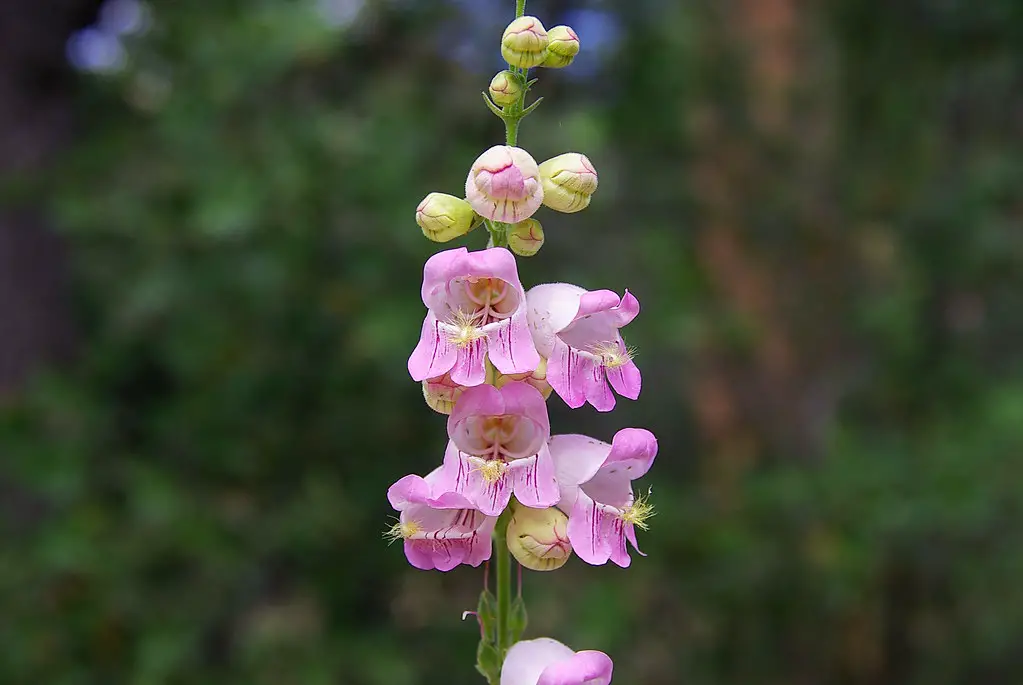Penstemon, often referred to as Beardtongue, is a genus of plants native to North America known for their bright, tubular flowers and lance-shaped foliage. There are around 250 species within the genus, each one offering unique color variations and bloom times. The perennial nature of Penstemon makes it a mainstay in gardens and landscapes where it can attract hummingbirds and butterflies.
Penstemon’s beauty lies in its vibrant flower spikes that can range in color from deep purples and blues to bright reds and pinks. Flowering mainly in late spring to early summer, they make excellent additions to borders, rock gardens, or wildflower gardens. Penstemon’s low maintenance and adaptability to various environmental conditions make it a favorite among both novice and experienced gardeners.
Though primarily found in the wild in various regions across North America, Penstemons have been cultivated to create hybrids that suit a variety of garden settings. These adaptations have allowed Penstemon to become a versatile plant, thriving in different climates and soil types.
| Aspect | Details |
|---|---|
| Common Names | Beardtongue, Penstemon |
| Botanical Name | Penstemon |
| Family | Plantaginaceae |
| Plant Type | Perennial |
| Mature Size | 1-3 feet |
| Sun Exposure | Full Sun to Partial Shade |
| Soil Type | Well-drained, Sandy to Loamy Soil |
| Hardiness Zones | 4-9 |
| Native Area | North America |
Penstemon Care
Penstemon care is straightforward, appealing to gardeners who wish for a perennial that offers beauty without requiring excessive attention. They need a sunny spot, well-drained soil, and some watering to thrive, particularly in their first year. Established plants have good drought tolerance, making them suitable for xeriscaping.
A key to Penstemon’s success in the garden is proper soil preparation and correct planting depth. They like to be planted no deeper than they were in their nursery pots and appreciate a bit of compost at planting time. These simple care steps can lead to years of colorful blooms.
Light Requirement for Penstemon
Full sun is ideal for Penstemon, as it promotes the most vigorous growth and profuse blooming. However, they can tolerate partial shade, especially in hotter climates where afternoon shade can prevent scorching. Providing at least six hours of sunlight per day will ensure healthy growth.
Soil Requirements for Penstemon
Penstemon prefers well-drained soil, ranging from sandy to loamy. Soil that retains too much moisture can lead to root rot. If planting in a clay-heavy soil, it can be amended with sand or gravel to improve drainage. A slightly acidic to neutral pH is optimal for these plants.
Water Requirements for Penstemon
While Penstemon is somewhat drought-tolerant, it does benefit from regular watering, especially during its first year. Once established, it can withstand dry spells, but consistent moisture will promote healthier growth and more abundant flowering. Avoid overwatering, as it can cause root rot.
Temperature and Humidity
Penstemon is adaptable to a wide range of temperatures and humidity levels, reflecting its native habitat’s diversity. It is winter hardy in USDA zones 4-9 and can tolerate heat if provided with adequate water. Humidity is generally not a concern for Penstemon, and it can thrive in both dry and humid climates.
Fertilizer
Fertilizing is generally unnecessary for Penstemon, especially if planted in well-composted soil. Over-fertilization can lead to leggy growth and reduced flowering. If desired, a light application of a balanced fertilizer in early spring can provide a boost.
Pruning Penstemon
Pruning can be beneficial to maintain shape and encourage further blooming. Deadheading spent flowers can prompt a second bloom, while cutting back in late fall can tidy the plant and promote new growth in spring.
Propagating Penstemon
Propagation of Penstemon is commonly done through division or stem cuttings. Dividing mature plants in early spring can rejuvenate growth, while stem cuttings can be taken in late summer for rooting. Both methods are relatively simple and can help expand the garden’s Penstemon collection.
How To Grow Penstemon From Seed
Growing Penstemon from seed can be a rewarding endeavor. Start seeds indoors 6-8 weeks before the last frost date, or sow directly outdoors in early spring. Provide light and warmth, and keep the soil lightly moist until germination.
Common Pests & Plant Diseases
Aphids
Small insects that can be treated with insecticidal soap or neem oil.
Powdery Mildew
A fungal disease that can be managed with proper air circulation and fungicides if needed.
Common Problems With Penstemon
Leggy Growth
Usually caused by too much shade or over-fertilization. Ensure proper sunlight and avoid excess fertilizing.
Root Rot
Often a result of overwatering or poorly drained soil. Amend the soil to improve drainage and water appropriately.
Poor Flowering
Lack of blooming may be due to too much shade, poor soil, or overcrowded plants. Adjust the conditions to encourage flowering.
Pro Tips
- Plant Penstemon in clusters to create a dramatic visual impact in the garden.
- Use Penstemon to attract pollinators like hummingbirds and bees to your garden.
- Choose native Penstemon species for a more naturalized and low-maintenance garden setting.




